While anxiety is simply defined as the behavior of someone who experiences distress or nervousness, it may have a multitude of causes and resolutions. At one extreme, with some help it can fade in only weeks. At the other, the best approach may be just learning to manage the issues. You’ll find some general discussion here on types of anxiety, mixed in with a number of representative case histories.
The Majority of the Dogs
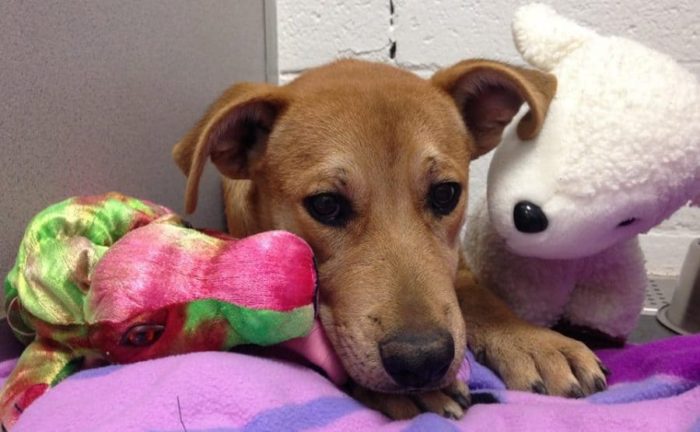
Over the years, the vast majority of anxious dogs I’ve seen have been due to what may be described as Predictive Anxiety and Skills Deficits. Pulling that apart, the dog is nervous because he doesn’t really know what to expect will happen. And for what little he may expect, he lacks the skills to manage it to his satisfaction. Whether this relates to other people, dogs, or whatever, it is primarily a problem in education. One that needs a focus on effective communication and compassionate teaching.
Gypsy here was a perfect example of that, as a young pup found in the streets. A guy managed to grab her, getting bitten in the process, so she was turned over to a municipal animal control with a bite record, which did not bode well. He asked a local rescue to pull the dog, but they wouldn’t without a suitable foster arranged, so here she came.
With that, let’s try to clarify the goal here, which will be dependent on both your needs and the dog’s interest. If your dog is afraid of other people and you’re often going to be walking by many others, you need him to behave calmly. If he’s also interested in other people, he needs to know how to greet them. But if he isn’t really that interested, he still has to learn how to politely avoid them, with perhaps only a very brief greeting.
Similarly with meeting other dogs, just how much he needs to learn depends on his interest, bearing in mind that his interests may change as he becomes more familiar. But, I’ve had dogs who, after they learned how to manage others at the dog park, choose to just sit near a bench and only watch, or to leave for a walk.
Anything you try to add here on positive reinforcement or classical reward conditioning only relates to some of the tools you’d be using for the above goals. Lose sight of this and it may take you far longer than it should to help the dog. About the same thing applies to stuffing food in the dog’s mouth. Food will often act as an anxiolytic to help calm him down, but it also serves as a distraction and teaches nothing useful.
Yes, food can be used as a reward after desired behaviors are performed, and using food is often the easiest way to teach many people to communicate this to dogs. However, that shouldn’t be the eventual reason for the dog’s action. Instead, they should be finding acceptable ways to interact with new things in the world in a way that gives them pleasure, which is also called positive self- or auto-reinforcement.
The Majority at the Dog Park
In the past few years I’ve seen a number of people trying to bring these anxious dogs to the dog park, to hopefully acquire some socialization. These dogs will often growl or air snap if another dog approaches, and while many social dogs will understand this, young pups can be an issue. Too often people do not understand, and escalate from yelling at their dog, to grabbing and holding his snout, or to finally hitting him in frustration as nothing else seems to work. This often produces the opposite of their desired effect, and the situation worsens.
But, this is at most fear aggression, and in many cases the dog is only saying that they are scared. So, why would they sometimes still approach another dog, then start growling? Because they do have an interest in meeting the other dog, and the growl is just to say they are scared and to please go very slow. My dog has worked with hundreds like this, and knows when and how to approach, or to sometimes just relax a few feet away, to let them settle down, and wait for their approach.
Another common characteristic is that, if the dog is strongly bonded to that person, he will often appear to be far more aggressive to other dogs when near the person, even though he runs back to them for support. This often also applies with other people and strange places, like the veterinarian or the groomer, where they may need to have the owner leave the room so that the dog can calm down.
People will commonly label this increased aggression as protection, but the dog does not believe their person needs protection, nor would he even know how to offer this. Instead, it’s more related to resource guarding, as the person is their security resource, and somewhat of a safe zone. As social skills and confidence build, this will fade.
Another common problem is people believing that their dog will only learn if she would just get out there and play, and they keep pushing the dog away. However, scared dogs usually start by spending most of the time near their people, and just watching. They begin by making short and brief trips out to meet a dog or try something, then get scared and run back. Over time, the trips slowly become farther and longer, until they finally may just ignore their people and play. But, this is a scary process, which involves learning new social and play skills, with much of that done by trial and error. It may take a half-dozen or more trips, but by pushing the dog away they are less able to calm down. And instead of speeding things up, that can take many times longer, or simply continue to fail.
As for the owner, they need to focus on how to calm and reassure the dog. And this should be done not while the dog is hiding, but while facing the other dogs at a comfortable distance. If the dog’s growl or air snap includes lunging of more than a few inches, or repeatedly moving forward, it’s time to immediately intervene. Some training is then needed to get the dog’s attention, and to show them that simply backing away (increased distance) will help them to calm and settle down. Something you’ll read more about with Lulu the Pittie below.
With some of those cases where they growl at another dog from a few feet away, I’ll just quietly walk over. I’ll put a gentle hand on their back, and softly speak to them in reassuring tones. I do not want to forcibly stop their growling, but to do that by patient calming and reassurance, all while they remain looking at the other dog. Now, just above I spoke about many scared dogs being more aggressive if they are near you when another dog approaches. However, when you instead walk over to your dog, the situation and results are usually quite different.
The More Passive Dogs at the Dog Park
These are the ones who rarely show any type of aggression, but on entering will just try to hide, run, or roll over in submission. There are a number of variations here, and some of these dogs simply cannot start off by handling a bunch of new dogs at once, and will do much better starting with one to two other dogs. Many will quickly learn that freezing while on their backs has all the other dogs stopping, but a few get too nervous and repeatedly either continue to wiggle or jump up and run again, just repeating the run and roll over and over.
What is needed depends largely on the other dogs present. At a local dog park, most of the long-time regulars will play this chase for a few minutes, then recognize what’s happening. They will stop chasing the dog, and wait for her to approach them. Dogs who have less social skills, being younger or scared, can be problems where you need to rapidly intercede.
There is another reason for an entering dog running wildly and rolling over as other dogs approach which has noting to do with the dog’s anxiety, but is a type of play. For more on this, see cheerleaders.
I’ve seen some older dogs who simply don’t understand this, but who seem to become scared and frustrated at the passive dog’s behavior. And, instead of walking away, they try growling and correcting her behavior. They are telling her to stop doing this, without realizing that she doesn’t yet have another way to behave. Unfortunately, this particular situation will often very rapidly degrade to fear aggression, where the passive dog is attacked in an effort to get her to stop the scary behavior. This is similar to what may happen if you meet a loose dog on the street and your dog panics.
A Reactive Growl while Leash Walking
Once each week or so, we pass by a leashed dog who gets more and more excited as he comes closer to mine. Unlike a young pup jumping to play, this guy has jerky movements, may be running back and forth or pulling, and is often growling. The owner’s often pulling him while telling him to be nice or behave. When they do say something, it’s often along the lines of their dog simply not liking other dogs. Of course, this can also happen when two dogs (housemates) are walked together, and then it becomes only strange dogs that he dislikes.
Most of these people appear set in their views, and not open for any discussion. For those who appear a little distressed by this, I offer them a card giving this website for advice. And, very occasionally, I meet somebody who is open to explore the issue.
While walking a wooded trail I saw one woman rapidly pick up her small dog every time another dog passed. When she did this by me I stopped for a moment, and she then explained that her dog is not really aggressive, but only becomes too excited. I agreed with her opinion, and suggested she put her down down while one of mine approaches, as they are trained to deal with this. A moment later the two dogs were fine, and I then allowed my other two to approach. Here, she seemed to understand the issue, but knew that many other people didn’t. That they might become alarmed, and that many of them were walking dogs with little socialization.
And if the Dog Really Isn’t Interested?
I know several people with Border Collies or Heelers who are entirely and completely focused on their job. They are fine near other dogs, but simply have no interest in any dog they don’t happen to live with. Walking by any of them, they simply don’t even react to my dogs being there. If a loose pup should run up to them, the socialized dog will freeze and show teeth with a low growl, politely warning the other dog to back away. With them, socialization is more about how to politely and effectively avoid other dogs, instead of greeting and playing. If they lack socialization, the initial behavior will be the same, but they may become far more reactive if the other dog does not leave quickly. However, both cases will simply ignore all dogs passing by.
The point being, if the dog becomes very excited at a distance from other dogs, that is far more likely to happen from interest than anything else. That many start to calm down on the first meeting with a very social dog, but others may require a half-dozen or more sessions. That socialization is actually more difficult with lack of interest, such as the Border Collie I just spoke about.
The Older or Experienced Dogs
Depending on the breed, the older dogs may require far more time to learn new things, and a longer history of prior learned behaviors may conflict with what you’re trying to teach. At the animal shelters, the backyard dogs were taken in as cute pups and just left in the yard until they were more of a problem than they were worth. From this start, they have little or no prior experience and are ready to start learning.
But I’ve found other dogs at the shelter who would ignore you and jump all over, as they were taught by volunteers who had been told by their (sic) behavior expert to reward them with plenty of treats when not jumping. So, of course, the dogs all learned to jump for attention, then stop for treats. Similarly, the dogs learned other behaviors that needed to be changed in order to learn good social skills.

Nikki was a 6-year old Siberian Husky at the shelter and an owner surrender who was kept outside. She came in with considerable previous experience, including knowing how to open most doors and gates, and just ignored most people and anything you might try to say.
Combine these two issues, with a 9-year old large breed, and what I described here could take a year or more, and might never be fully completed.
Anxiety and Targeted Behavioral Momentum
I’ve seen some dogs who appear generally fine, except for just a few little things, which seem to be from their past. All learned behaviors have some degree of momentum or persistence. And for young pups, some types of behaviors are both learned much faster and are also more persistent over time. While some of these may be overt actions, others may be anxieties that are difficult to control.
We do occasionally read warnings from trainers that scaring a dog even once can sort of leave them marked for life. That’s actually a process called traumatic learning, which has quite a high threshold before it kicks in, so they’re mostly blowing smoke here. Whenever I get to actually look at their examples, the poor dog is so scared of so many things that she’s already on the edge here.
Instead, the training’s going along just fine, then we come to something where she just won’t budge, no matter what. The best approach here may be to change the scenario enough that you are able to approach a similar issue but from a direction unfamiliar to the dog. It takes a bit of thought and experimentation, but is often the fastest, and sometimes the only practical, solution. And once you have accomplished this, with reliable behavior, often you can then very slowly move it back to the original case.
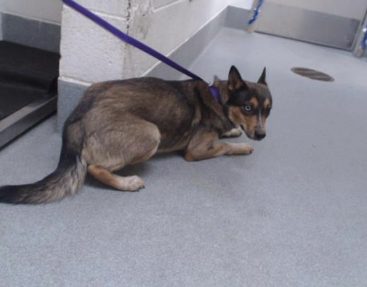
Fresca spent months at the shelter never leaving her kennel. Taking her outside she’d panic and claw at the ground enough to have bloody paws. Less afraid of being carried, I took her to rooms to work with her. Once later comfortable in a home, she was given access to the outside that was under her control. After a few days of watching the other dogs going out, she slowly took her first steps. A few weeks later she was able to explore stores and a dog park.
The key with Fresca started with her interest in new behavior in scenarios where she wasn’t so afraid. Then, setting it up so that something (here, the other dogs) attracted her to the outside, but where she had full control of when and how far she went.
Trust, a Solution – to Nothing
I was often fostering shelter dogs like Fresca, taking them to the point where they could be adopted or could move to a regular foster. I would send with them a description of their current behavior and what was working to help them. Fresca was at the point where she only needed reassurance, and a great deal of slow exposure to the world in order to keep learning. Instead, the woman fostering insisted that all the dog needed was trust, and all would be good. She refused to listen to anything I said, and a week later posted on how happy she was that Fresca would now jump up on her bed, and that this dog was making such great progress.
In reality, however, Fresca had done that behavior weeks earlier, and her treatment had the dog more scared and regressing. Over time, as Fresca now had enough background skills and interest to keep going, she will make it. Just much slower than it would have been. However, there appeared to be no way that you could explain or even demonstrate something to people like that, and even the rescue that sponsored this didn’t see any issue with it. And this is part of the reason why this dog spent so many months never leaving her kennel.
While trust is one component of feeling secure, it does absolutely nothing to solve their problem of how to deal with the world. To learn playing tennis or swimming in a pool, no amount of trust in your instructor will teach you what to do or gain any skills, not unless they explain and guide you as you try things. With that, I’ve seen so many similar dogs in shelters and rescues, with some (perhaps the luckier ones) spending many months or even years with a foster home, where they just don’t believe anything better or faster could be done.
Trauma and recovery
Occasionally I see a dog who appears to be pretty well shut down and afraid of most anything. But if it seems to be a more controlled retreat from the world, I suspect it’s possibly just acute trauma. A local shelter brought in a bunch of new dogs and pointed me to Meeka, who refused to come out of her crate.
Meeka later comfortably walked into the house and seemed familiar with everything. My dogs walked over but immediately picked up on her body language, and quietly gave her space. She found a bed and was eating well, seeming more withdrawn than scared, so we all just left her to settle back and try to relax. After about three days Meeka made an overture to one of the dogs, followed by a lot of sniffing and walking around with them.
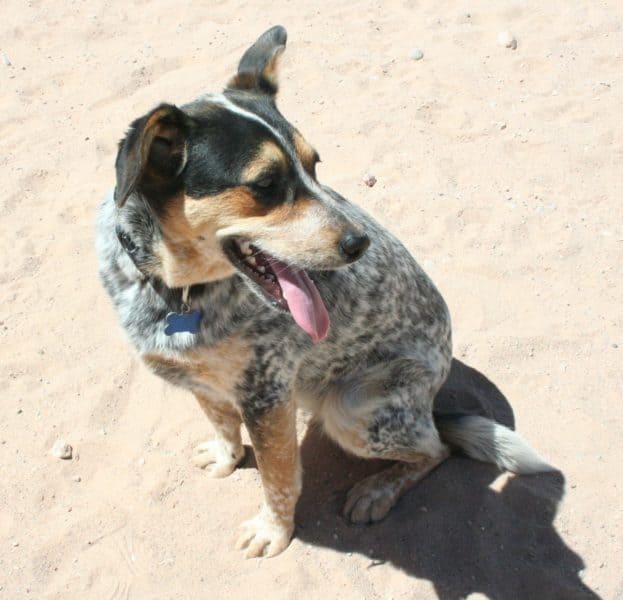
In another two days, Meeka was out back running and jumping with all the others. A few more days and she demonstrated that she was already leash, crate, car, and house trained, and fine with meeting new dogs at the park. So nothing more to really do here, other than giving her another week to finish recovering.
Trauma and Skills Deficit
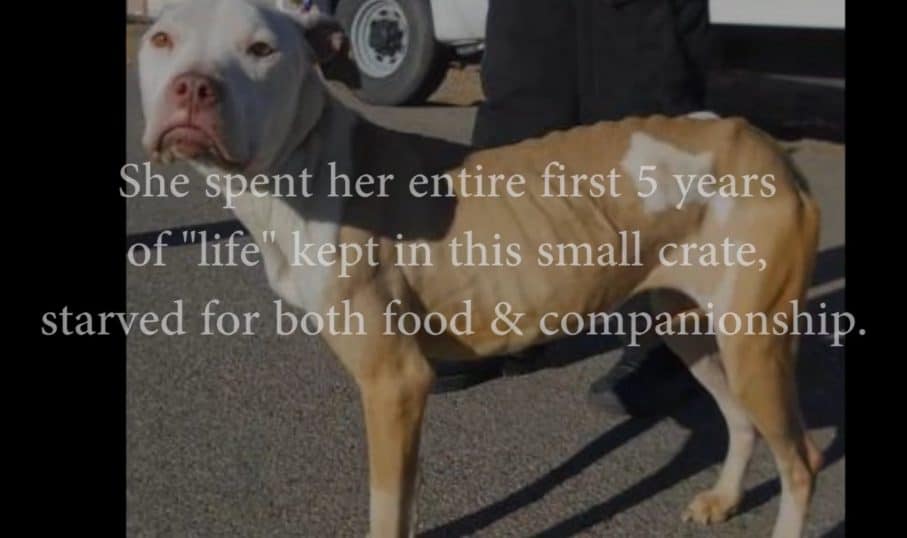
When Animal Control had come out to handle an issue with snakes they saw this dog and her condition and removed her. A rescue stepped up and took her in to try and help.

Far worse than a young Backyard Dog just confined to the yard, Junebug was much older and suffered both mentally and physically from her very long confinement and starvation. It took months to first restore her physical health.
Afraid of everything, Junebug fixated on the woman running the rescue as her only security. While she would tolerate her absence, even when seeing her at a distance Junebug would go crazy trying to reach her and could barely be restrained. She tried sending her to a foster, but each time Junebug would find some way to escape, and only a very few people could then get close enough to catch her.
Running out of space the rescue tried boarding her, but Junebug became increasingly agitated and aggressive with both people and other dogs. Until one day, when I received a tearful phone call from the rescue. She explained Junebug’s history, and that she was now at her wit’s end and needed to either find some new solution or have to put the dog down. And that time was short, as she was boarded at VCS Veterinary, but they wanted her removed for severe aggression.
I arranged to come over and meet outside of VCS. While Junebug was nervous, the rescue woman seemed even worse, and I had to keep calming her down as I spent about 20 minutes introducing myself to Junebug. At that point the “Bug” was ready to go and we just left for home.
Helping the Bug
I had one dog at home then, who had been trained for rehabilitation, so he knew how to avoid any of the aggression that Junebug had shown with other dogs. Because of the extended trauma, Junebug’s rehabilitation took longer than most but involved nothing new or unusual. After the first week she was well settled in, and never once did she ever attempt to escape.
Obviously, part of the reason for Junebug’s aggression was her lacking the social skills for relating to people and other dogs. But, there was another component here, which caused her prior fosters and boarding to fail. While this particular dog rescue had a reputation for taking on difficult cases, they had caused some of this issue. While it’s surely flattering to have a dog always want to be right next to you and even jump over any obstacles to reach you, allowing that singular focus with no teaching component means that you are her only concern and security in the entire world and that the dog will never really learn anything else.

She had taught Junebug this so strongly that it took months to even weaken that behavior. In the meantime, Junebug started to learn about the world, one piece at a time. She became best friends with my dog, and helped him in working with several other fosters.
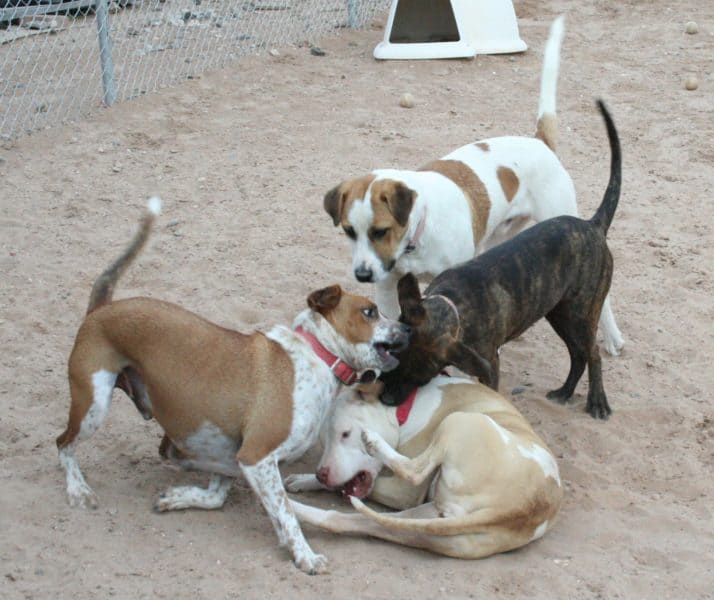
She loved to play and could handle several dogs on top of her while still being in control. Months later she returned to the rescue, this time being easy to handle, safe with all other dogs, and even spent time at events in a kissing booth, greeting people.
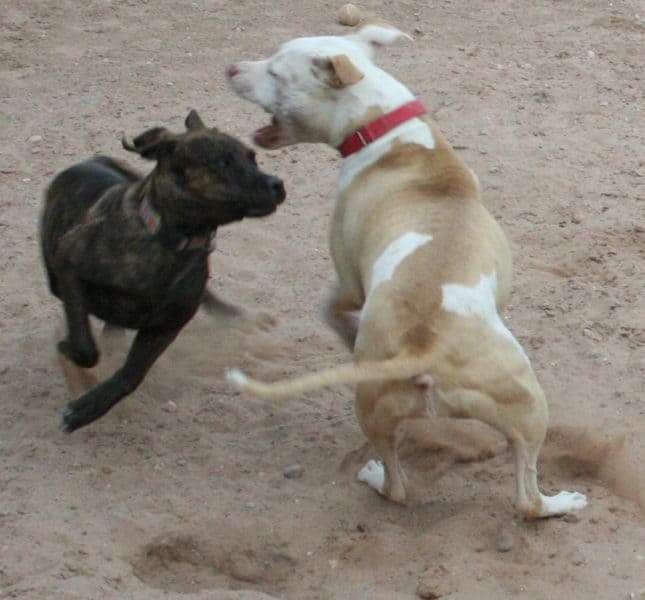
As they had trouble finding a home for her, Junebug returned here a few more times, sort of as vacations, and often helped with other fosters. Here, Junebug really bonded with young Princess and they became like sisters.
Over the years I worked with nearly two dozen dogs from that rescue but never could get the rescue person to understand the issues that she worsened with Junebug and how that could change. In the meantime, she seemed to have trouble with a few other dogs, mainly ones that did not show her much attention, and I pulled a few from her kennels for a bit as they were getting irritable. Yes, there was a bit of a pattern there. While she did care for all the dogs, she had never learned the skills needed to care for some of them.
The rescue had just worked with so many dogs for so very long, and there were so many people who saw her as an expert, that she just wasn’t willing or able to change, especially as her approach would somewhat work with the majority of dogs. Of course, anybody reading this who happens to have known Junebug likely never heard this part of the story, only seeing how much she changed. As is typical with nearly all rescues and shelters, most bad information about dogs is suppressed.
Anxiety, the Pathology
There are some dogs who seem to be inherently afraid, never for only a single item, but for a variety of scenarios. During training, some of this will pop up at different times and places, and often requires some way to work around it. I recall one previously feral dog at an animal shelter who would not allow people to even slowly approach until she was about 8-years old. However, I was able to teach Lucky a different approach sequence, while holding out a leash. After a few slow passes in a circle she would pause, I would put the slip lead on, and we’d go out for a walk.
I could never approach her on the walk, but she walked very nicely and enjoyed it enough to learn a sequence for the leash being put on and off. After a year or so I managed to get another person to watch what I did and try this, and It worked just as well with him. However, no amount of high-value food rewards were ever able to modify her behavior, and several other people had just given up on her. Instead of the days or weeks that a typical dog might need to get past this, Lucky’s progress could only be measured in years.
I later learned that Lucky’s behavior was likely due to many generations of inbreeding, and was also seen in many other members of the large inbred group she came from. I worked with several others from that group, some with similar but worse behavior issues. After nearly 8 years at the shelter, Lucky would finally allow other people to slowly approach her in a typical manner.
Medication may help in a few cases and may be used to reduce anxiety enough to allow more learning. I’ve seen some cases where just a few months is enough to get things started. In the most severe cases, the medication ends up being used for simple maintenance, to allow some reasonable quality of life. In many of those cases, there are so many things that the dog is so very anxious about, that this may be the only practical choice.
Curiously, this sometimes appears with very targeted areas. One dog was great with people and all other dogs, but scared of cars and anything new. Some are fine in the home, but terrified leaving it. Two others learned other dogs in a few weeks, but never really learned social skills with people.
Anxiety and Force-Free Positive Only
When a dog has no social skills but is interested in other dogs, they will often walk pretty close to another dog before their interest is equaled by their fear. At that point, they have a choice of flight, fight, or freeze. A local municipal shelter tried applying their Shy Dog Program to a young pittie who went for the fight choice. I had only seen a little of that program, but it seemed to emphasize minimum force and maximum treats, with an emphasis purportedly on positive reinforcement. Past that, they clearly felt entirely confident in their own expertise, and wouldn’t discuss details.
I first met this dog when a trainer wanted to take her on a local TV show with her, so I pulled her for just a few days, to calm her down from the shelter stress. I heard that Lulu did great on the show and the trainer tried to foster her, but ran into trouble with her small dog and returned Lulu to the shelter.
At that point the shelter put Lulu into their program, trying for four months before admitting they were getting nowhere. As she was often aggressive at times, Lulu was nearing the point of being put down, so one of their staff contacted me to see if I had an opening. While they were not willing to allow her near any dog at that point, I did take my training dog with me to pick her up, and she immediately deferred to him and all was peaceful.
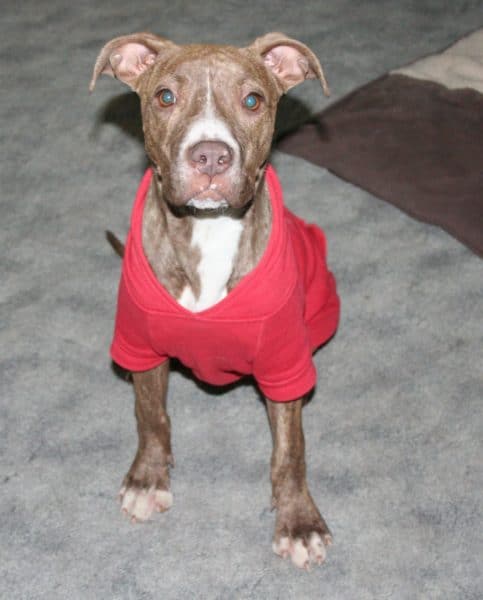
As Lulu settled in, my assessment indicated that her issue was far worse than I had previously seen. Before, there would be a considerable fear warning before any action, but now she’d just charge in for an attack. And this seemed to be a direct result of their program which at no point ever directly taught her how to behave with another dog, or introduced her to highly social dogs.
Instead, I let my dog handle the first lessons, teaching Lulu basic manners and behaviors. A 2nd dog here then started teaching her play skills.
By then, Lulu was just fine with all my dogs, and we started on leash, house, car, and crate training. At this point, however, the original problem was still there, but we had now added some resources to help in dealing with it. The remaining item needed was control training, where Lulu learned to stop and back away on command, no matter what the situation. She did this when playing, sniffing something new, or just anytime she was walking towards something.
Finally, we had all the needed pieces, focusing on education instead of some arbitrary Force-Free protocols, and none of this required distracting her with treats. Her first outside meeting was arranged with a Bull Mastiff I knew well. The Mastiff understood the issue, and every time Lulu might charge in, both Bella the Mastiff and I made her back up and wait. Soon, Lulu realized that doing that made her feel better and that if she backed up every time she became afraid, she would soon be able to walk closer and closer without fear.
From the few, to the many
After meeting a few other similar dogs we were now ready for the tedious part. It’s one thing to meet socially skilled dogs, but another to meet those ranging from young pups to scared dogs, and from little Chi’s to Great Danes. At this point, Lulu was following my guidance well enough to continue, but it took weeks of time to locate and work with what I recall was about sixty other dogs. Normally it doesn’t take this long, except here the shelter’s four months of their Shy Dog program had really made things worse, and also another issue had arisen.
A local newspaper in Albuquerque had embarked on a crusade, claiming the animal shelter was adopting out Dangerous Dogs. At the shelter, one of their media-connected staff tried accusing their director with a letter containing the list of many such dangerous dogs that had left the shelter. And, of course, it turned out that Lulu happened to be the very first one on his list, accused of being aggressive with any other animals. Therefore, I had to really make sure this one would work out!
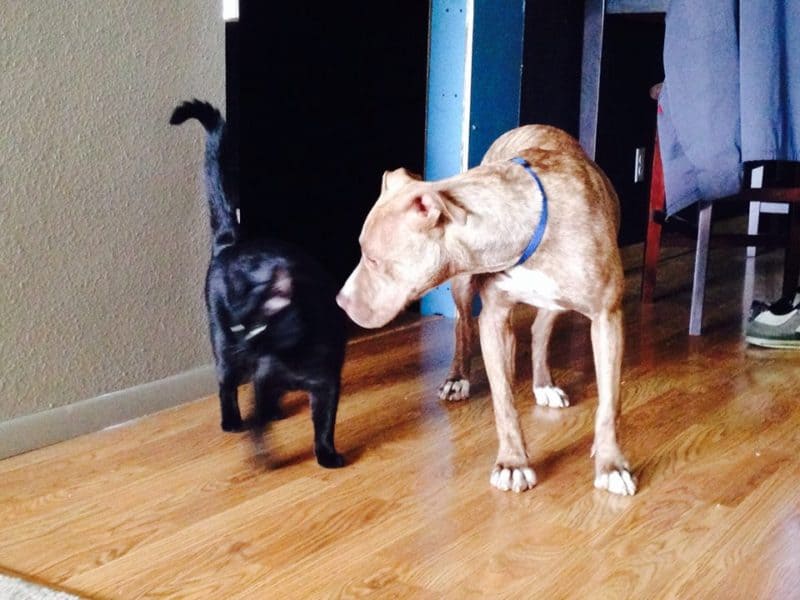
After a bit of searching, Lulu was adopted and they sent me a picture of this horribly aggressive Dangerous Dog meeting her new sister. Then, later on, another sister joined the group.
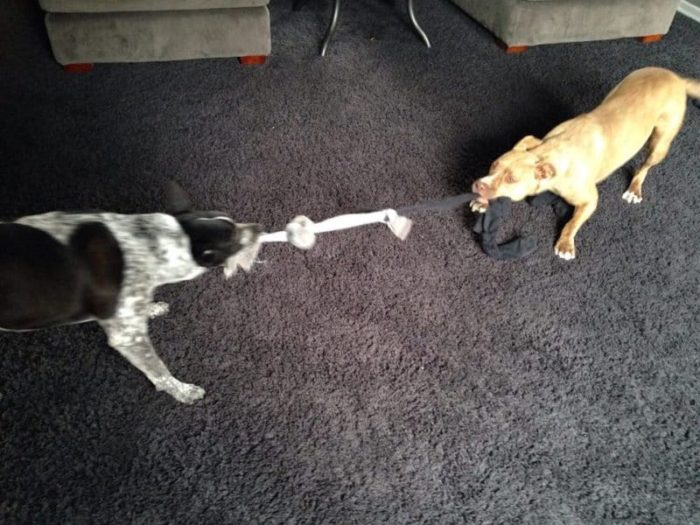
Due to the newspaper’s crusade, the shelter was required to send a letter of explanation to all adopters of potentially dangerous dogs. Their director told me that Lulu’s new owner (who happened to be a cop) thought they were nuts. But, all the publicity resulted in the director soon being asked to resign.
This case is another example of the need for compassionate teaching, but also shows the danger of people insisting that their favorite solution is the one that will fit. While there are a number of varying approaches I may use with a shy dog, their program allowed only one and prevented any outside assistance.
